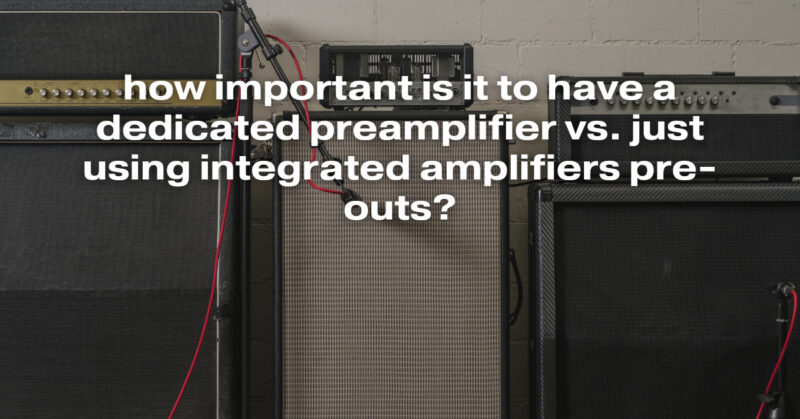The world of audio components can be complex and filled with choices. When it comes to building a high-quality audio system, one decision that audiophiles often grapple with is whether to use a dedicated preamplifier or rely on the pre-outs of integrated amplifiers. To understand the importance of this choice, let’s explore the roles of preamplifiers and integrated amplifiers and the factors that influence the decision.
The Role of Preamplifiers
A preamplifier, or preamp, is a critical component in an audio system. Its primary functions include:
- Signal Processing: Preamplifiers adjust and fine-tune audio signals. They control volume, balance, tone, and sometimes provide tone-shaping options like bass and treble controls.
- Source Selection: Preamplifiers allow users to switch between various audio sources, such as CD players, turntables, streaming devices, and more.
- Input Matching: Preamplifiers often provide impedance matching and gain adjustments to ensure that the source device and the power amplifier are properly matched for optimal performance.
- Signal Isolation: They help isolate the source components from the power amplifier, reducing interference and preserving signal purity.
Integrated Amplifiers and Their Pre-Outs
Integrated amplifiers combine both preamplifier and power amplifier functions into a single unit. While integrated amplifiers provide convenience and cost savings, they may have limitations compared to dedicated preamplifiers:
- Limited Upgradability: Integrated amplifiers may have limited expansion options. If you want to upgrade either the preamp or power amp section, you may need to replace the entire unit.
- Interference Potential: In integrated amplifiers, the preamp and power amp sections share the same chassis. This proximity can lead to electromagnetic interference, potentially degrading the audio signal.
Factors to Consider
When deciding between a dedicated preamplifier and using the pre-outs of an integrated amplifier, several factors come into play:
1. Audio Quality
Dedicated preamplifiers are designed with audio quality as a top priority. They often feature high-quality components, advanced circuitry, and superior signal processing capabilities. If audio purity and fidelity are paramount, a dedicated preamplifier may offer a noticeable improvement.
2. Flexibility
Integrated amplifiers offer convenience and simplicity, making them suitable for compact systems or those with limited space. However, dedicated preamplifiers provide greater flexibility for customization, allowing audiophiles to mix and match components for precise tuning.
3. Future Upgrades
Consider your long-term audio goals. If you anticipate upgrading different components of your audio system over time, a dedicated preamplifier can facilitate this process by allowing you to retain your existing power amplifier or switch to a different one without replacing the entire unit.
4. Budget
Budget constraints can play a significant role in your decision. Integrated amplifiers are often more cost-effective, while dedicated preamplifiers can be a more significant investment. Determine your budget and prioritize the components that matter most to you.
Conclusion
The choice between a dedicated preamplifier and using integrated amplifier pre-outs ultimately depends on your specific needs and priorities. If you seek the highest audio quality, customization options, and plan to upgrade your system over time, a dedicated preamplifier may be the better choice. However, if simplicity, cost-effectiveness, and space-saving are important to you, integrated amplifiers with pre-outs can deliver excellent performance. Ultimately, the “best” choice is the one that aligns with your audio goals and budget.


